Subject:
The Kalkadoon and the
Mitakoodi
Date: November
27, 1994 14:06
16:42 Alice Springs, Northern Territory :: 27 OCT 94
Some time ago near Mt. Isa in Queensland, I picked up the following brochure
at a roadside historic site. Been meaning to get around to it. Couldn't
find it when I was writing THE OUTBACK EXPERIENCE post which would have
been the obvious point to bring it up.
This is perhaps a little long, but stick with it to the end. Besides,
how often are my posts short, anyway?
The Kalkadoon and Mitakoodi Memorial
Corella River, Mount Isa-Cloncurry Highway
ORIGINS
The Australian Aborigines (Boories or Koories) came to Australia in
successive waves from South India during the last Ice Age, some 40,000
years ago. In 1788, they numbered abut 300,000 people in 600 tribes
with many different languages or dialects and concentrating along the
tropical northern fringes of the continent. For instances, little Mornington
Island has three tribes and the whole of Tasmania had only four.
They traded such things as axe heads with their neighbours and had
joint corroborees but were never a nation with a central organization
in the modern sense. They had no dwellings, cultivations or food producing
animals or birds. The wheel was unknown to them and they normally went
naked.
Nevertheless they had a well-organized culture with totem symbols and
their rock art was superior to that of stone age cultures elsewhere
in the world. Two of these tribes were the Kalkadoon inhabiting the
range of hills running in an arc from Selwyn to Mount Isa to Kajabbi
and the Mitakoodi who lived the Cloncurry River basin and their languages
were as different as French and English.
THE COMING OF THE EUROPEAN
It's obvious that this age old situation could not continue into the
modern world and occupation by others was inevitable. When Dampier in
the seventeenth century and Cook in the eighteenth came to Australia,
they saw no buildings, no cultivations, no beasts of burden, none of
the trappings of civilization, only a few wild and naked men wandering
about: they considered the land Terra Nulla or No man's land and informed
the British Government accordingly.
The aborigine must not blame the European for this. Simply, the latter
was lacking in imagination: he could not conceive that men like his
own ancestors who went through the similar Neolithic stone age were
there busy in their own simple way as his own forefathers had been.
The Aborigine was as it turned out fortunate that the occupation was
not by several different countries with different languages and cultures
but by the English, Irish, Scots and Welsh, the British mix who are
with al their faults the most enterprising, energetic law abiding and
tolerant combination history who built up the Commonwealth of Nations,
the United States of America whose speech is destined to become the
universal language of mankind. He could not know that in time, he would
join them as an equal member.
It was this formidable combination reinforced in the Twentieth Century
by the Germans, Italians and Chines who confronted the stone age aborigine
armed only with spear, nulla nulla and boomerang.
He saw these thrusting newcomers parcel out his land between themselves
filling it with their sheep and cattle, effectively cutting off his
means of sustenance and separating him from his sacred sites and traditional
ways.
Should not our hearts go out to this poor man who unhappy and bewildered
was reduced to begging for salt, tea and flour on the outskirts of European's
towns?
In general the loss of language and culture followed detribalisation
and was not the invaders' deliberate policy and apart from some instances
of killings, poisoning and massacre the European treated the "blackfellow"
humanely even kindly but he left no doubt as to who was boss.
BATTLE MOUNTAIN
Few aboriginal tribes struck back, notable exceptions being the Palmer
River tribe and the Kalkadoons who in 1884 charged down Battle Mountain
near Kajabbi against the invader. What chance had spear and boomerang
against Urquhart's mounted troops with carbines? They were killed almost
to a man, a terrible reprisal for the spearing of cattle and the killing
and eating of a few Europeans and Chinese.
The Kalkadoon was a broken man and his numbers and those of the Mitakoodi
were further reduced by the European's diseases such as measles leading
to pneumonia.
Australia-wide the Aborigine's numbers declined to about 60,000 and
some Europeans considered them a dying race. But Adam in ochre is made
of sterner stuff and in recent times his numbers have doubled to around
120,000. This has been due to a slow and steady improvement in their
position from the low point in the 1800s to the provision of schools,
hospitals, housing, supermarkets etc. a process far from complete but
proceeding at an ever faster pace as the European's conscience asserts
itself.
Brown Adam has lost his Stone Age Garden of Eden but his children have
been accepted as free, equal and valued members of modern Australian
society, continuing to make their own distinctive contribution.
For every one thing he lost, they have gained a hundred.
THE ABORIGINAL HIMSELF
The Aborigine at his best is a fine man, soft spoken with a twinkle
in his brown eyes, loving his home and his children and having a fine
sense of mateship. He has been described as "Nature's Gentleman".
His wife is a motherly person full of human kindness. He is somewhat
shy and can be hurt like anyone else by the insults of the arrogant
and the ignorant.
He has had to leap from the Stone Age in the short space of two hundred
years making a profound change and emotional adjustment, a process which
took the European 50,000 years.
Small wonder then that some had fallen by the wayside prompting certain
Europeans to stigmatise the whole race as "dirty, drunken and diseased".
These remarks in fact only apply to a very small percentage of Aborigines
and in dealing with these, we should follow the teachings of Jesus of
Nazareth, the greatest man who ever lived.
- Is he dirty? Shower him.
- Is he drunk? Counsel him.
- Is he sick? Treat him.
- Is he unemployed? Give him a job.
- Is he ignorant? Teach him.
- Does he despair and take his own life in prison? Pray for his soul
and,
- Does he do well? Praise him.
Jesus taught that we are all children of God and therefore spiritually
brothers. Science reinforces this by telling us that if we go back some
four million years we are all descended from common stock and so physically
related to every other human being on earth and therefore physically
brothers by extension.
There is no answer to racial problems but this principle of brotherhood.
No man regards his own brother as an inferior being.
What if scientists claim that the Aborigine is not the intellectual
equal of the European? That is neither here nor there.
Robert Burns said "A man's a man for a 'that and a 'that".
The European who patronises or condescends toward the Aborigine should
reflect that the latter is his equal before God.
Always, always therefore treat him not only as a man but as a brother.
If I were asked to give him a word of advice, it would be this, "Hold
your head high and be as proud of your race as I am of mine."
Remember, the best is yet to come.

 DAVID
HARVEY SUTTON
DAVID
HARVEY SUTTON
THE MONUMENTS
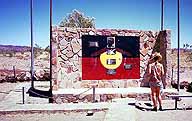
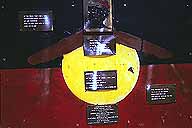
These consist of a wall along the tribal boundary between the Kalkadoon
and Mitakoodi. On the eastern side as you face Mount Isa are depicted
a spear and a boomerang both broken, an etching in brass of the head
of a Kalkadoon warrior and a central plaque stating,
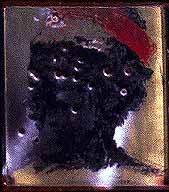
- YOU WHO PASS BY
- ARE NOW ENTERING THE ANCIENT
- TRIBAL LANDS OF THE KALKADOON
- DISPOSSESSED BY THE EUROPEAN
- HONOUR THEIR NAME
- BE BROTHER AND SISTER TO
- THEIR DESCENDANTS
and three plaques bearing poems. From left to right the first depicts
the ascendancy of Brown Adam over all natural things.
- Up this track that's now a road
- spear in hand, brown Adam strode
- his was everything
- Bare the back that knew no load,
- naked but a king!
the second the fight at Battle Mountain near Kajabbi
- Spear can never conquer gun,
- man no more the horse outrun.
- By the gunblast tossed
- still in death lies every one
- and the battle's lost
and the third the cry of anguish of the Kalkadoon as he imagines all
is lost forever,
- River and rockface and tree
- taken and cut off from me
- in heartache and fear;
- scattered the wild and the free
- and broken the spear.
An acknowledgment plaque and an Aboriginal flag background complete
the picture. 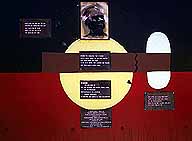
On the western side as you face Cloncurry are depicted a spear and
stone axe both broken, an etching in brass of the head of a Mitakoodi
warrior and a central plaque stating,
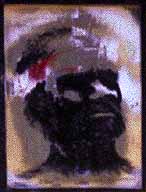
- YOU WHO PASS BY
- ARE NOW ENTERING THE ANCIENT
- TRIBAL LANDS OF THE MITAKOODI
- DISPOSSESSED BY THE EUROPEAN
- HONOUR THEIR NAME
- BE BROTHER AND SISTER TO
- THEIR DESCENDANTS
and three plaques bearing poems. From left to right the first depicts
the Aborigine's timeless existence in the bushland,
- Earth and the sun and the sky
- knowing not wherefore or why
- they each saw me roam,
- happy to live and die
- the bushland my home
the second, his disappearance from the bushland,
- Bounds the kangaroo they stalked
- cattle graze where the wild men walked
- and their camps have been.
- Silent bush where they laughed and talked
- and their slate's wiped clean
and the third his great leap forward to the modern age and as he confronts
his problems here, he weeps for the loss of his former idealised existence,
- Age upon age, slow time crept
- swift to the space age I leapt
- at the hours decree:
- back to the past turned and wept
- for that timeless me
An acknowledgment plaque and the Aboriginal flag complete the picture.
The Australian flag on one side of the monument symbolises the Aborigine's
membership of our nation: on the other side is the Aboriginal identity
flag, the black symbolising the people, red the earth and the yellow
circle the sun.
The two flags are not in opposition, rather does one complement the
other. The poems are Japanese Tanka of thirty-one syllables each but
unlike the original, metered and rhymed to please the Anglo-Celtic ear.
Wow! I'm not certain who or what this is really a monument to. Imagine,
a memorial to a conquered and destroyed culture, expressed through a second
culture's artistic form, and rearranged in style and execution to "please
the ear" of the conquering culture. It's often said that funerals
are events staged for the benefit of the survivors; this monument appears
of that tradition.
Let's first set about diffusing some inaccuracies, omissions and misleading
wordings.
ORIGINS
There is no conclusive evidence in the anthropological record pinpointing
the origin of Aboriginal colonists to Australia or the date at which colonisation
began. The earliest evidence of an Aboriginal presence was unearthed in
this decade and was dated to be in excess of 60,000 years old so they've
been here at least that long. Indonesia, New Guinea and a few other SE
Asian locations are listed as possible points of Aboriginal origin, but
these are the speculation of a scientific community that assumes man originated
in Africa. If you ask an Aboriginal they're likely to tell you they originated
in Australia [an opinion reinforced for me just last night by a Native
American woman-pmj 11/11/94].
The figure of 300,000 Aborigines in 1788 is another outdated estimate.
Recent research indicates that as many as 1 million Aborigines inhabited
Australia at that date, and perhaps more.
Aboriginal trade items included stone and wooden implements, ochre and
foodstuffs and other goods. The trade network extended for thousands of
kilometers beyond neighbours. Even today Aborigines perceive themselves
to be made up of distinct peoples; in 1788 they spoke in excess of 200
languages so why should we expect that they would have formed a single
"nation" with a centralised government? On the other hand, their
sophisticated and continent wide organisational network appears
to have operated quite effectively for thousands of years without significant
upheaval.
In all regions of Australia, Aborigines built shelters, some temporary,
others erected as permanent structures but used cyclically as they moved
about their territory, and in some areas of Australia where the Aborigines
were not nomadic these were constructed as permanent dwellings.
Where weather patterns were temperate year-round they wore no unnecessary
clothing. In Tasmania, Victoria and generally in the cooler southern climes
they wore clothes. I don't see that this defines the Northerners as any
more 'savage' or 'primitive' simply because they "normally went naked"
as this brochure appears to imply.
THE COMING OF THE EUROPEAN
I'm tempted to just reword this whole section...
Given the imperialistic nature of Europe's colonial period, it was
inevitable that the indigenous peoples of Australia would, like all
other such peoples in the world, be displaced, murdered and the survivors
eventually detribalize. When Dampier and Cook came they confused technologically
simple with simply animal and informed the British Government that nothing
with a soul inhabited Australia.
The Aborigine should not blame present day Europeans for the ignorance
of their ancestors and thus should expect neither conciliation nor compensation
for past deeds. After all, Europeans were once 'primitive,' 'simple'
and 'wild' but are much better now, thank-you, and are willing to help
the Aboriginal out of their pitifully primitive state.
Aborigines should consider themselves lucky that those dirty Dutch,
Portuguese, Spanish and French didn't get to them. Those peoples would
have done much worse than detribalize, rend families apart, massacre
entire tribes and then treat the survivors as persona-non-grata right
up until the present day. The Dutch, for instance, would never have
given them the right to vote in the 1960s, less than 200 years after
occupation, like the British. And "illegally" killing an Aboriginal
in the 19th century wouldn't even have cost a police officer his promotion
like it did in the Australia occupied by the "British mix".
He could not know that in time, he would join them as an equal member,
the promise he is continually given by politicians, even today. Of course,
it's not the fault of Australians now if the Aborigine did not then
and does not now care to join them, as an equal member or otherwise.
You can't stop progress and all peoples of the world are better off
once they join in Western Civilization.
Yes, it could have been much, much worse.
13:03 Whistler, BC-Canada :: 27 NOV 94
A month later and this brochure still brings me to a boil. I take exception
to just about every line in it, but this one's perhaps the worst:
- For every one thing he lost, they have gained a hundred.
I need to find an accountant with this spin on positive gains.
What have they lost? Demoralizing poverty in a 'land of plenty'; often
spotty medical treatment for imported disease; embarrassing infant mortality
and teen suicide rates; mothers separated from children; the right to
compete for low pay jobs or, when the government 'misguidedly' legislates
equal pay for equal work, the right to apply for unemployment or welfare;
their land pilfered; the practice of their culture criminalized.
But what have they gained?
Some of the pilfered land is being returned. Mind you, only untenanted
land (read, inhospitable or unprofitable) is eligible.
- Brown Adam has lost his Stone Age Garden of Eden
- but his children have been accepted as free,
- equal and valued members of modern Australian society...
This flies in the face of reality. His children have been legislated
to be free and equal within Australian law, true. But accepted
as equal and valued members of Australian society? Not in practice.
Not even close.
It's important to recognize that, other than the return of their land,
Aborigines did not seek any of Australian society's gains. In fact, they
resisted them. They went to the missionaries not to find food or shelter,
Jesus or Capitalism but to seek refuge from murderous pastoralists and
police. Even then, the brochure in question adequately describes the image
of Aborigines in the mind of Australia Fair:
- There is no answer to racial problems but
- [the] principle of brotherhood. No man regards
- his own brother as an inferior being.
- What if scientists claim that the Aborigine is not
- the intellectual equal of the European? That is
- neither here nor there.
Not inferior in their worthiness before god, just in intellectual capacity
on earth.
Grrrrr.
Patrick.
-- Responses Sought --
- I believe in the immense skill of white surgeons.
- But how can I not believe in the evil abilities of the
- Medicine-Men and the sorcerers?
- I have the evidence of my own eyes to persuade me.
- I have the memory of my own harrowing experience.
- I have my tribal traditions.
- I am confused, but not disillusioned.
- Say, if you like, that I'm just a superstitious Aboriginal.
| |
 |
Waipuldanya of the Alawa (Phillip Roberts)
From "I, the Aboriginal"
with Douglas Lockwood |